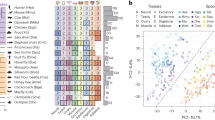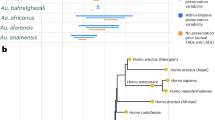Abstract
THE guinea-pig (Caviaporcellus), traditionally classified as a New World hystricomorph rodent, often shows anomalous morphological and molecular features in comparison with other eutherian mammals1–14. For example, its insulin differs from that of other mammals in anabolic and growth-promoting activities and in its capability to form hexamers5,6. Indeed, the literature about the molecular evolution of guinea-pigs abounds in references to 'convergent evolution', 'extremely rapid rates of substitution', and 'unique evolutionary mechanisms'. These claims are based on the assumption that the guinea-pig is a rodent. Our phylogenetic analyses of amino-acid sequence data, however, imply that the guinea-pig diverged before the separation of the primates and the artiodactyls from the myomorph rodents (rats and mice). If true, then the myomorphs and the caviomorphs do not constitute a natural clade, and the Caviomorpha (or the Histricomorpha) should be elevated in taxonomical rank and regarded as a separate mammalian order distinct from the Rodentia. If, as suggested by recent data15,16, the myomorphs branched off before the divergence among the carnivores, lagomorphs, artiodactyls and primates, then the new order would represent an early divergence in eutherian radiation.
This is a preview of subscription content, access via your institution
Access options
Subscribe to this journal
Receive 51 print issues and online access
$199.00 per year
only $3.90 per issue
Buy this article
- Purchase on Springer Link
- Instant access to full article PDF
Prices may be subject to local taxes which are calculated during checkout
Similar content being viewed by others
References
Nowak, R. M. & Paradiso, J. L. Walker's Mammals of the World (Johns Hopkins University Press, Baltimore, 1983).
Romer, A. S. Notes and Comments on Vertebrate Paleontology (University of Chicago Press, 1968).
Sahni, A. in Evolutionary Relationships among Rodents: A Multidisciplinary Analysis (eds Luckett, W. P. & Hartenberger, J-L.) 133–150 (Plenum, New York, 1985).
Wood, A. E. in Evolutionary Relationships among Rodents: A Multidisciplinary Analysis (eds Luckett, W. P. & Hartenberger, J.-L.) 475–509 (Plenum, New York, 1985).
Beintema, J. J. & Campagne, R. N. Molec. Biol. Evol. 4, 10–18 (1987).
Watt, V. M. J. biol. Chem. 260, 10926–10929 (1985).
Manao, G. et al. J. Prot. Chem. 7, 417–426 (1988).
Shinomura, Y., Eng, J., Rattan, S. C. & Yalow, R. S. Comp. Biochem. Physiol. 96B, 239–242 (1990).
Beintema, J. J. & Neuteboom, B. J. molec. Evol. 19, 145–152 (1983).
Sarkar, G., Koeberl, D. D. & Sommer, S. S. Genomics 6, 133–143 (1990).
Fan, Z.-W., Eng, J., Shaw, G. & Yalow, R. S. Peptides 9, 429–431 (1988).
Smith, A. I. et al. J. Endocr. 115, R5–R8 (1987).
Wolfe, P. B. & Cebra, J. J. Molec. Immun. 17, 1493–1505 (1980).
Eng, J., Du, B.-H., Raufman, J.-P. & Yalow, R. S. Peptides 7, Suppl. 1, 17–20 (1986).
Easteal, S. Genetics 124, 165–173 (1990).
Li, W.-H., Gouy, M., Sharp, P. M., O'Huigin, C. & Yang, Y.-W. Proc. natn. Acad. Sci. U.S.A. 87, 6703–6707 (1990).
Fitch, W. M. Am. Nat. 16, 111–120 (1980).
Felsenstein, J. Syst. Zool. 34, 152–161 (1985).
Li, W.-H. & Gouy, M. Meth. Enzym. 183, 645–659 (1990).
Fitch, W. M. & Beintema, J. J. Molec. Biol. Evol. 7, 438–443 (1990).
Sarich, V. M. & Wilson, A. C. Science 158, 1200–1203 (1973).
Shoshani, J., Goodman, M., Czelusniak, J. & Braunitzer, G. in Evolutionary Relationships among Rodents: A Multidisciplinary Analysis (eds Luckett, W. P. & Hartenberger, J.-L. ) 191–210 (Plenum, New York, 1985).
Yu, J.-H., Eng, J., Rattan, S. & Yalow, R. S. Peptides 10, 1195–1197 (1989).
Li, W.-H., Wu, C.-I. & Luo, C.-C. Molec. Biol. Evol. 2, 150–174 (1985).
Felsenstein, J. Syst. Zool. 27, 401–410 (1978).
Author information
Authors and Affiliations
Rights and permissions
About this article
Cite this article
Graur, D., Hide, W. & Li, WH. Is the guinea-pig a rodent?. Nature 351, 649–652 (1991). https://doi.org/10.1038/351649a0
Received:
Accepted:
Issue Date:
DOI: https://doi.org/10.1038/351649a0
This article is cited by
-
Complete mitochondrial genome of the Eurasian flying squirrel Pteromys volans (Sciuromorpha, Sciuridae) and revision of rodent phylogeny
Molecular Biology Reports (2013)
-
Identification of novel cyclic nucleotide phosphodiesterase gene cDNAs in the brain of guinea pig
Neuroscience Bulletin (2010)
-
Automated Removal of Noisy Data in Phylogenomic Analyses
Journal of Molecular Evolution (2010)
-
Rodent phylogeny revised: analysis of six nuclear genes from all major rodent clades
BMC Evolutionary Biology (2009)
-
Phylogenetic analyses of complete mitochondrial genome sequences suggest a basal divergence of the enigmatic rodent Anomalurus
BMC Evolutionary Biology (2007)
Comments
By submitting a comment you agree to abide by our Terms and Community Guidelines. If you find something abusive or that does not comply with our terms or guidelines please flag it as inappropriate.



